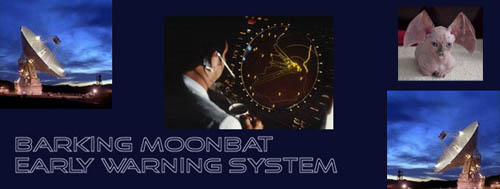
Oops?
”Iridium satellites are unusual because their orbit is so low and they move so fast. Most communications satellites are in much higher orbits and don’t move relative to each other, which means collisions are rare.
Smart people, don’t think too hard on that last one. I’m pretty sure the more distant satellites need to move even faster than the closer ones. “
I think they’re talking about the satellites in geosynchronous orbit. Yes, they are going faster but from the ground appear to stay still.
Reporters just aren’t rocket scientists.....
Posted by TimO 02/13/2009 at 12:21 AM
02/13/2009 at 12:21 AM
Can’t be I don’t think, if I remember correctly you can’t get a geostationary orbit that far away from the equator. And believe it or not, objects in a lower freefall orbit have to move *faster* for that orbit to be stable. It sounds backwards, but it’s true.
A geostationary satellite travels at 1.91 miles per second: 6877.8mph.
A low orbit satellite has to travel much faster to overcome the increased gravity and the drag induced by gas particles of the very outer atmosphere. Thus they travel at about 14,500mph (27,400kph). It is no pun saying that that is truly an astronomical velocity.
Low Earth Orbit, or “LEO” is an altitude region from 100 to 1240 miles up. Anything lower than that will fall back to earth (if too slow) or burn up from friction (if fast enough). 200 miles up is the orbital zone of convenience where most of these satellites are placed.
Grumpy was right, I was wrong.
However, these LEO satellites are not geostationary. They are moving much faster than the earth. The usual period of revolution is about 90 minutes. This is where I made my mistake, assuming the satellites at that height were in a fixed position relative to the ground (ie geostationary). They are not. They can not be. The velocity that requires is not enough to hold them up; they would crash and burn.
The satellites in this article were at a special orbital height call a sun-synchronous orbit. This specific altitude, about 500 miles, is above the convenient LEO altitude and well below geostationary (22,236 miles), so the satellites travel a bit slower than the LEO satellites. The interesting thing about their orbit is that they will pass over the same piece of ground at the same time each day.
You can play with the math and calculate the required velocity for any object in orbit at a given altitude. Conversely you can take a velocity and calculate the orbital altitude that will give you. Hey, it’s rocket science, and that means math. Fun!
http://en.wikipedia.org/wiki/Geostationary
http://en.wikipedia.org/wiki/Low_Earth_Orbit
http://en.wikipedia.org/wiki/Sun-synchronous_orbit